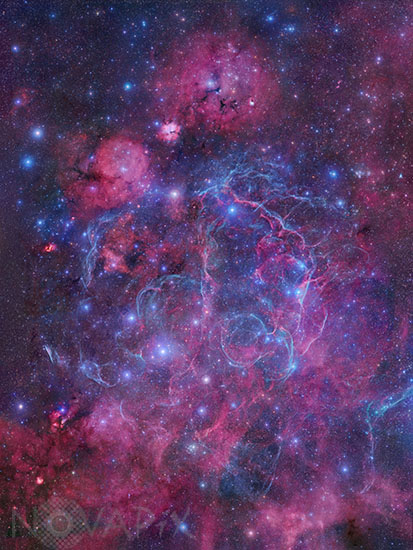Photo Agency - Astronomy - Space - Nature

The Vela supernova remnant
author: R.Gendler/Novapix
reference: a-snv11-00084
Image Size 300 DPI: 31 * 42 cm
Approximately 11,000 to 12,000 years ago a massive star exploded in the southern constellation of Vela. The matter ejected by the supernova scattered the contents of the star into the surrounding interstellar medium creating shock fronts of multimillion degree gas and high energy particles. The heated matter produces brilliant visible light as well as radio and x-ray emission which will continue for thousands of years until the entire remnant of the dying star completely dissipates into space. Supernovas enrich the surrounding interstellar medium with heavier elements like carbon, nitrogen, oxygen, silicon, sulfur, and iron which can only be created by the intense heat within the nuclear furnaces of stars. Supernovas play a significant role in the dynamics and ecology of galaxies as the expanding shock fronts trigger the collapse of nearby molecular clouds which then leads to the birth of new generations of stars. Supernovas are essential to the establishment of life as several of the critical heavier elements found within living organisms can only be formed or disbursed by the violent destruction of massive stars. 117 Frame Mosaic Image.
Keywords for this photo:
2015 - ASTRONOMY - EVOLUTION - GUM 23 - NEUTRON STAR - NGC 2736 - PULSAR - RCW 36 - SOUTHERN HEMISPHERE - STAR - SUPERNOVA - SUPERNOVA REMNANT - VELA -
Contact : Stéphane Aubin +33-(0)9-51-26-53-76
© Novapix - All rights reserved


